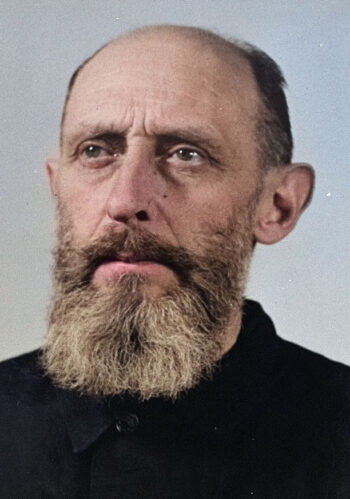Blobel, Paul

Right before the beginning of the war against the Soviet Union, SS Standartenführer Paul Blobel (13 Aug. 1894 – 7 June 1951) was assigned head of Sonderkommando 4a within Einsatzgruppe C in Ukraine. According to the Einsatzgruppen reports, his men were involved in the mass execution of Jews, among them the claimed massacre at Babi Yar, which has since been refuted by air photos. Due to severe health problems resulting from excessive alcohol consumption, he was relieved of his duty in January 1942 and underwent extended health treatments in the following months.
He then is said to have been put in charge of implementing “Aktion 1005” in the eastern occupied territories, which allegedly was an – albeit technically impossible – grand-scale operation to eliminate all traces of Einsatzgruppen mass graves in Eastern Europe by exhumation and cremation. To this end, Blobel supposedly started out by conducting experiments with open-air incinerations at the Chełmno Camp, the results of which were allegedly implemented in the various extermination camps, such as Auschwitz, Belzec, Sobibór and Treblinka.
However, in his postwar depositions, Blobel never mentioned any cremation experiments conducted at Chełmno, and never mentioned the term “Aktion 1005” either. The tale of the Chełmno experiments was invented by former Auschwitz Camp Commandant Rudolf Höss in his postwar statements.
At the Chełmno Camp, a primitive field furnace was built, presumably for the cremation of dead deportees. (See the entry on that camp for details.) However, such a facility was neither erected in any other camp, nor during the alleged mass cremations of “Aktion 1005.” Hence, if that field furnace was the result of experiments, neither Höss nor Blobel nor any other camp commandant adopted this cremation method.
Starting in early 1943, Blobel and his men allegedly roamed the huge area of still-German-occupied eastern territories in search of Einsatzgruppen mass graves, almost all traces of which he intended to eliminate by mid-1944. Apart from “confessions” by Blobel and his former associates made under duress while in Allied captivity, and numerous witness tales, there is no documentation to verify any of these claims.
Regarding attempts to eliminate the mass-murder victims buried at Babi Yar, Blobel claimed in an affidavit dated 18 June 1947 (NO-3947), that the bodies were eliminated by simply opening the mass graves, removing the top cover, drenching the exposed corpses with fuel, and set them on fire.
“It took about two days before the grave was burned down. I personally saw that the grave had smoldered through all the way to the bottom. After that, the grave was covered up, and with this all traces were as good as erased.”
In other words, in Paul Blobel’s world, bodies burned all by themselves after having been lit with some unspecified (evidently liquid) fuel. However, self-immolating bodies simply do not exist. Such bizarre statements are made only by people who have been coerced to make them, here probably by the customary torture that the Americans were inflicting on many if not most of their captives. (See the entry on torture.)
Blobel mentioned only one grave of a modest size (“55 m long, 3 m wide and 2½ deep”) that could have contained around one to two thousand bodies. If 100,000 victims had been buried at Babi Yar, as most other witnesses and thus the orthodox narrative claim, then there would have been up to 100 of these mass graves, not just one.
Blobel’s version stands in stark contrast to the claims made by alleged survivors among the inmates who claim to have been forced to exhume the bodies at Babi Yar. (See the entries on Semen Berlyant, Isaak Brodsky, David Budnik, Vladimir Davydov, Iosif Doliner, Yakov Kaper, Vladislav Kuklia, Leonid Ostrovsky, Yakov Steyuk, Ziama Trubakov.) They all agree that the corpses were extracted from the graves, and then burned on huge wooden pyres. Blobel made his statement while in U.S. captivity, whereas these survivor witnesses made their claims during interrogation by the Soviet terror organization NKGB (the successor of the NKVD and precursor of the KGB). In other words, while the Soviets could easily orchestrate the statements of the witnesses they interviewed (if need be, at gun point), Blobel was beyond their reach, so his statement was left unharmonized.
(For more details, see the entry on Aktion 1005 and Babi Yar, as well as Mattogno 2022c, pp. 541f., and 550-563.)
After a show trial, Blobel was executed by the Americans in 1951.

You need to be a registered user, logged into your account, and your comment must comply with our Acceptable Use Policy, for your comment to get published. (Click here to log in or register.)